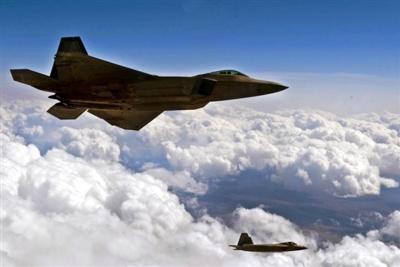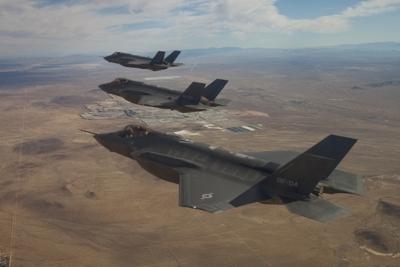Fifth-Generation Fighter Aircraft Are Key To America
Maintaining Domain Dominance In The Years Ahead
Seaking at a media roundtable in the Pentagon Tuesday, Lt. Gen.
Christopher D. Miller, deputy chief of staff for strategic plans
and programs, and Maj. Gen. Noel T. “Tom” Jones, the
service’s director for operation capability requirements,
said the technology – exemplified in the F-22 and F-35
– assumes greater importance in combating growing
anti-access, area-denial capabilities.

Fifth-generation aircraft are particularly valuable as part of
the new defense strategy guidance that President Barack Obama
unveiled here earlier this month, they said. That strategy
explicitly affirms that the United States military must be able to
defeat ant-access, area-denial threats. “This is not a new
thing,” Miller said. “Militaries have operated in
ant-access environments probably since the beginning of time. But
what is different, and why fifth-generation aircraft is relevant to
that, is that operating in anti-access environments continues to
become more complex and challenging.”
There is a continuing competition between nations developing
anti-access capabilities and others devising ways to defeat that,
the general said. “Fifth-generation aircraft are a key
ability that the Air Force is bringing to the nation’s
ability to operate in those environments,” he added.
The Air Force has flown against anti-access environments since
it was founded. American fighters countered this capability in the
skies over Korea and Vietnam. Airmen faced off against
surface-to-air missiles ringing Hanoi. In the Persian Gulf War,
airmen defeated the ground-to-air threat over Iraq, and most
recently, they knocked out the anti-access capabilities around
Tripoli. But missile technology has become more complex and more
difficult to counter. Command-and-control capabilities have grown.
This will require a new set of capabilities flying against them,
Jones told reporters. “The fifth-generation capabilities that
the F-22 and F-35 possess will allow us to deal with that
environment,” he said.
F-22s and F-35s bring maneuverability, survivability, advanced
avionics and stealth technology to the fight. Both planes are
multi-role capable, able to fight air-to-air and air-to-ground.
“These capabilities give our leaders the ability to hold any
target at risk, anywhere in the globe, at any time,” Jones
said. “I think it is important for any adversary to
understand we possess those capabilities and intend to continue the
development.”

Another aspect of the strategy includes the ability to operate
against adversaries across the spectrum of conflict. F-22s and
F-35s are particularly relevant at the top of the spectrum,
“where we can’t always set the conditions for our
operations as easily as we have in the last couple of decades of
military conflict,” Miller said.
This is an extremely valuable capability that must be nurtured,
the generals said.
Americans have become used to having domain dominance, Miller
said, expecting U.S. service members to be able to operate on land,
at sea, in the air with a fair degree of autonomy as they pursue
national objectives. “This is not a birthright,” Miller
said. “That is something we have had to work very hard in the
past to gain, … and we can’t take for granted that we
are going to be able to support the joint team in future
environments unless we maintain a high-end capability to target an
adversary’s air forces, their surface-to-air forces and
basically be able to seize control of parts of the air space and
other domains the joint commander needs.
“It’s an Air Force capability,” he added,
“but it’s a key Air Force contribution to the joint
warfighting capability of the nation.”
 Classic Aero-TV: Up Close And Personal - The Aeroshell Aerobatic Team at Oshkosh
Classic Aero-TV: Up Close And Personal - The Aeroshell Aerobatic Team at Oshkosh ANN's Daily Aero-Term (07.13.25): Tactical Air Navigation (TACAN)
ANN's Daily Aero-Term (07.13.25): Tactical Air Navigation (TACAN) ANN's Daily Aero-Linx (07.13.25)
ANN's Daily Aero-Linx (07.13.25) NTSB Prelim: Pitts S2
NTSB Prelim: Pitts S2 Airborne 07.09.25: B-17 Sentimental Journey, Airport Scandal, NORAD Intercepts
Airborne 07.09.25: B-17 Sentimental Journey, Airport Scandal, NORAD Intercepts




